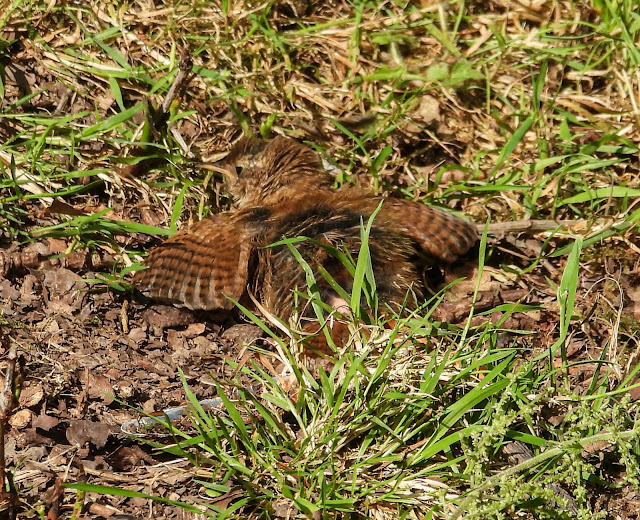The Eurasian wren (Troglodytes troglodytes), also known as the northern wren, is a diminutive bird, the sole representative of the wren family Troglodytidae found across Eurasia and Africa's Maghreb region. In Anglophone Europe, it is often simply referred to as the wren. This bird is characterized by its very short tail, typically held erect, a short neck, and a relatively long, thin bill. Its upperparts are russet brown, while the underparts are a paler buff-brown, complemented by a cream buff supercilium. Both sexes exhibit similar plumage.
This Blog contains Wildlife, Plants and Bird Photos from Walks, Safaris, Birding Trips and Vacations. Most of the pictures have been taken with my Nikon P900 and P950X cameras. Just click on any image for a larger picture. On the right column under the Blog Archive are the entries by date. Below that under Animal categories all the diffent species of Animals, Birds, Insects and Plants contained in the website are listed. Clicking on any entry will show all the entries for that species.
TOTAL PAGEVIEWS
TRANSLATE
Thursday, 24 July 2025
24-7-2025 FOTA WILDLIFE PARK COBH, IRELAND - EURASIAN WREN (Troglodytes troglodytes)
The Eurasian wren (Troglodytes troglodytes), also known as the northern wren, is a diminutive bird, the sole representative of the wren family Troglodytidae found across Eurasia and Africa's Maghreb region. In Anglophone Europe, it is often simply referred to as the wren. This bird is characterized by its very short tail, typically held erect, a short neck, and a relatively long, thin bill. Its upperparts are russet brown, while the underparts are a paler buff-brown, complemented by a cream buff supercilium. Both sexes exhibit similar plumage.
Tuesday, 15 July 2025
15-7-2025 AMSTERDAM ZOO, HOLLAND - EURASIAN WREN (Troglodytes troglodytes)
The Eurasian wren (Troglodytes troglodytes), also known as the northern wren, is a diminutive bird, the sole representative of the wren family Troglodytidae found across Eurasia and Africa's Maghreb region. In Anglophone Europe, it is often simply referred to as the wren. This bird is characterized by its very short tail, typically held erect, a short neck, and a relatively long, thin bill. Its upperparts are russet brown, while the underparts are a paler buff-brown, complemented by a cream buff supercilium. Both sexes exhibit similar plumage.
The Eurasian wren can be identified by its compact, robust body, rounded wings, and notably short tail. It measures approximately 9 to 10 cm in length with a wingspan ranging from 13 to 17 cm, and weighs around 10 g. The plumage varies geographically, with some isolated populations exhibiting distinct coloration.
The Eurasian wren occupies a wide range of habitats, including cultivated and uncultivated areas with bushes and low ground cover, such as gardens, hedgerows, thickets, plantations, woodland, and reed beds. It is also found in more open spaces with bramble clumps or gorse, rough pastures, moorland, boulder-strewn slopes, rocky coasts, and sea cliffs.
This Palearctic species is widespread, with the nominate race breeding in Europe up to the northern latitudes of Norway and Sweden, and extending south to Spain, France, Italy, and southern Russia. It also breeds in Western Asia as far east as Syria and is represented by various subspecies across its range, including isolated island populations.
The Eurasian wren is a ceaselessly active forager, darting about in search of insects among dense vegetation or within crevices. It is known for its quick, jerky movements and propensity to stay close to the ground, often being flushed from under overhangs or banks. The wren may occasionally ascend to higher canopies but generally prefers lower strata near the ground.
Sunday, 6 October 2024
6-10-2024 LOUGHILL, IRELAND - EURASIAN WREN (Troglodytes troglodytes)
Tuesday, 13 June 2023
13-6-2023 MADRID ZOO PARK, ESPANA - EURASIAN WREN (Troglodytes troglodytes)
The Eurasian wren (Troglodytes troglodytes) or northern wren is a very small insectivorous bird, and the only member of the wren family Troglodytidae found in Eurasia and Africa (Maghreb). In Anglophone Europe, it is commonly known simply as the wren. It has a very short tail which is often held erect, a short neck and a relatively long thin bill. It is russet brown above, paler buff-brown below and has a cream buff supercilium. The sexes are alike.










%2040.jpg)
%2030.jpg)
%2010.jpg)
%2011.jpg)
%2012.jpg)
%2014.jpg)
%2015.jpg)